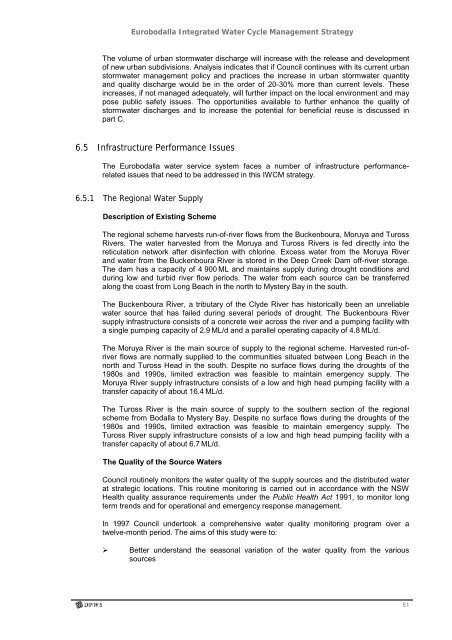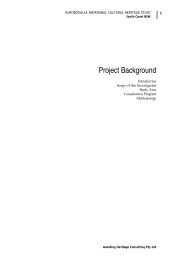Eurobodalla Integrated Water Cycle Management Strategy
Eurobodalla Integrated Water Cycle Management Strategy
Eurobodalla Integrated Water Cycle Management Strategy
You also want an ePaper? Increase the reach of your titles
YUMPU automatically turns print PDFs into web optimized ePapers that Google loves.
<strong>Eurobodalla</strong> <strong>Integrated</strong> <strong>Water</strong> <strong>Cycle</strong> <strong>Management</strong> <strong>Strategy</strong><br />
The volume of urban stormwater discharge will increase with the release and development<br />
of new urban subdivisions. Analysis indicates that if Council continues with its current urban<br />
stormwater management policy and practices the increase in urban stormwater quantity<br />
and quality discharge would be in the order of 20-30% more than current levels. These<br />
increases, if not managed adequately, will further impact on the local environment and may<br />
pose public safety issues. The opportunities available to further enhance the quality of<br />
stormwater discharges and to increase the potential for beneficial reuse is discussed in<br />
part C.<br />
6.5 Infrastructure Performance Issues<br />
The <strong>Eurobodalla</strong> water service system faces a number of infrastructure performancerelated<br />
issues that need to be addressed in this IWCM strategy.<br />
6.5.1 The Regional <strong>Water</strong> Supply<br />
Description of Existing Scheme<br />
The regional scheme harvests run-of-river flows from the Buckenboura, Moruya and Tuross<br />
Rivers. The water harvested from the Moruya and Tuross Rivers is fed directly into the<br />
reticulation network after disinfection with chlorine. Excess water from the Moruya River<br />
and water from the Buckenboura River is stored in the Deep Creek Dam off-river storage.<br />
The dam has a capacity of 4 900 ML and maintains supply during drought conditions and<br />
during low and turbid river flow periods. The water from each source can be transferred<br />
along the coast from Long Beach in the north to Mystery Bay in the south.<br />
The Buckenboura River, a tributary of the Clyde River has historically been an unreliable<br />
water source that has failed during several periods of drought. The Buckenboura River<br />
supply infrastructure consists of a concrete weir across the river and a pumping facility with<br />
a single pumping capacity of 2.9 ML/d and a parallel operating capacity of 4.8 ML/d.<br />
The Moruya River is the main source of supply to the regional scheme. Harvested run-ofriver<br />
flows are normally supplied to the communities situated between Long Beach in the<br />
north and Tuross Head in the south. Despite no surface flows during the droughts of the<br />
1980s and 1990s, limited extraction was feasible to maintain emergency supply. The<br />
Moruya River supply infrastructure consists of a low and high head pumping facility with a<br />
transfer capacity of about 16.4 ML/d.<br />
The Tuross River is the main source of supply to the southern section of the regional<br />
scheme from Bodalla to Mystery Bay. Despite no surface flows during the droughts of the<br />
1980s and 1990s, limited extraction was feasible to maintain emergency supply. The<br />
Tuross River supply infrastructure consists of a low and high head pumping facility with a<br />
transfer capacity of about 6.7 ML/d.<br />
The Quality of the Source <strong>Water</strong>s<br />
Council routinely monitors the water quality of the supply sources and the distributed water<br />
at strategic locations. This routine monitoring is carried out in accordance with the NSW<br />
Health quality assurance requirements under the Public Health Act 1991, to monitor long<br />
term trends and for operational and emergency response management.<br />
In 1997 Council undertook a comprehensive water quality monitoring program over a<br />
twelve-month period. The aims of this study were to:<br />
Better understand the seasonal variation of the water quality from the various<br />
sources<br />
51

















